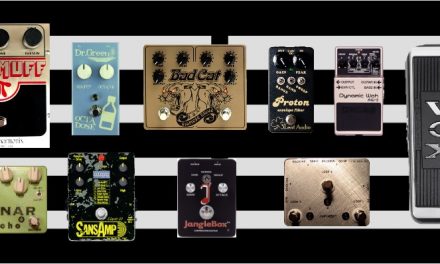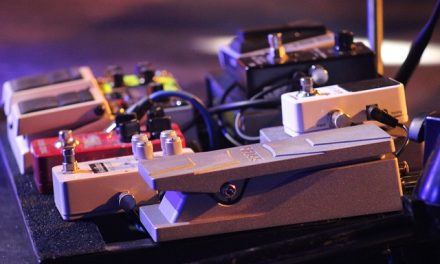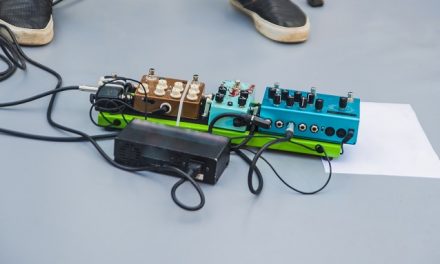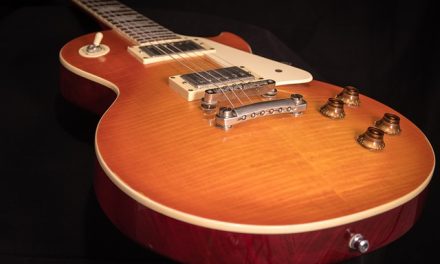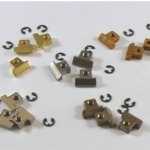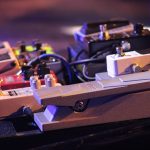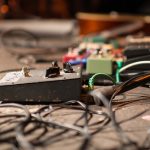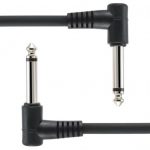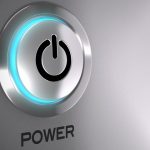Any links on this page that lead to products on Amazon are affiliate links and I earn a commission if you make a purchase. Thanks in advance for your support!
7 Best Pedal Board Power Supplies
Let’s face it – power supplies for effects pedals just aren’t sexy. You’d probably much rather spend money on some cool new pedals. And until now, even thinking about which of the best pedal board power supplies to buy probably hasn’t been a top priority.
But if you’re reading this, you know that a great power supply can make a big difference in your sound.
Although there’s nothing wrong with powering your effects pedals with batteries, at some point it becomes necessary to buy a power supply once you own more than a couple of pedals.
So, I’ve put together this review of the top effects pedal power supplies to help you choose one that’s right for you. And all the power supplies I’ve chosen are isolated power supplies as they are by far superior to non-isolated power supplies.
Power Supply Buyer’s Checklist
If you’re new to power supplies, be sure to check out my Pedal Power Supply Buyers Guide after the reviews.
Here’s a quick checklist of questions to consider:
- Does it have enough outputs to power all my current effects and effects I may add in the future?
- Can it output all the voltages my pedals require, plus those I may add later?
- Can it output enough mA “juice” for my pedals (especially newer ones)?
- Is it non-isolated or isolated? (Isolated is the way to go)
- Can it be mounted under my pedal board to save space?
Best Affordable Pedal Power Supply (Under $100)
Best Pro-Level Pedal Power Supply (Over $100)
Check out my complete series of pedal board articles:
Best Affordable Pedal Power Supply (Under $100) Reviews
Asmuse Power Station Isolated Power Supply Review
Asmuse is a Chinese company selling power supplies under the following brand names:
- Power Station (8 outputs, isolated power)
- Caline Power (6 outputs, isolated power)
- Pedal Power (10 outputs, non-isolated)
Note: The Pedal Power is not recommended as it only provides non-isolated power.
Of the three Asmuse products, the Power Station is the best option for an inexpensive isolated power supply.
It has eight isolated outputs configured in the following manner:
- Six 9V, 200mA outputs
- Two outputs (A & B) that are 200mA and switchable between 9V, 12V, and 18V
The Power Station also includes an isolated short circuit protector with LED indicator. It’s powered by a 12V noise-isolated power adaptor (wall wart).
The Power Station also comes with eight DC power cables and a polarity cable
Overall, it’s a great pick for an inexpensive isolated power supply with lots of voltage options.
PROS
- Best value for the price
- Can output 9V, 12V, and 18V
- 200mA outputs available to power newer pedals
CONS
- None
Asmuse Power Station Isolated Power Supply
Asmuse Caline Power Review
The Caline Power is a popular option for anyone needing a very small power supply. It’s a 6-output isolated power supply that measures just 3” x 1.5” x 0.87”.
The Caline Power should fit under many smaller pedal boards. If you can’t undermount it, it’s also an ideal choice for top mounting as it will take up as little space as possible.
The tradeoff for its tiny size is this – it only outputs 9V. However, you do get:
- two outputs at 100mA
- two outputs at 200mA
The Caline Power comes with eight DC power cables, and it’s powered by a 12V noise-isolated power adaptor (wall wart).
PROS
- Very inexpensive isolated power supply
- Tiny size will fit any pedalboard
- Both 100mA and 200mA outputs
CONS
- 9V power output only
Asmuse Caline Power Supply
GOKKO Guitar Pedal Power Supply Review
The Gokko Pedal Power is another isolated power supply that offers many output voltage configurations at a bargain price.
Made of aluminum, it’s lightweight and portable.
It has ten isolated outputs that are configured in the following manner:
- four 9V, 100mA outputs
- three 9V, 300mA outputs
- one 9V, 500mA output
- one 12V, 300mA output
- one 18V, 100mA output
The Gokko also includes isolated short circuit protection with blue LED indicator for each output, a nice feature not usually found in power supplies at this price.
As a nice bonus, The Gokko includes a 5V USB port for charging phones, tablets or other devices.
And finally, it comes with 10 power cables to connect your pedals.
PROS
- My Top Pick for the features at this price
- Lots of power output options
- USB charging port a plus
CONS
- None
GOKKO Guitar Pedal Power Supply
Joyo JP-05 Rechargeable Power Supply Review
The Joyo JP-05 is a popular mid-priced isolated power supply with a twist: it has a built-in battery for continuous use without AC power. Its dimensions are 5.7” x 2.6” x 1.4” and it weighs 2.15 pounds.
The JP-05 has eight outputs configured as follows:
- four 9V, 100mA outputs
- three 9V, 500mA outputs
- One 9V/12V/18V, 100mA output, adjustable
Each output has independent isolated power with overload and short-circuit protection that helps to protect your pedals from damage.
Built-in Lithium Battery
Different from other power supplies in this price range is its built-in 7.4V/ 4400mA rechargeable lithium battery pack.
It takes 2.5 hours to fully charge the battery, but once charged it can last up to 10 hours when used with eight analog pedals, or 2 hours with high current digital pedals. It’s a welcome feature for on-the-go travel use where AC power is not available or just as a backup power source if AC power goes out.
It’s also convenient at gigs with low-quality AC power where you’re picking up hum and buzzes; unplugging from the AC and running on batteries can stop this problem.
The Joyo JP-05 also includes a 5V USB port for charging any USB devices including phones and tablets.
Finally, it comes with eight power cables and an adaptor cable.
PROS
- Lots of power options
- Dependable and very quiet
- Battery can last for a whole recording session or gig if needed
CONS
- None
Joyo JP-05 Rechargeable Power Supply Review
Donner DP-1 | DP-2 | DP-3 | DP-4 Reviews
Donner is a well-known maker of power supplies with four different popular models. I’ll outline the differences between the four models in their own reviews. For reference, here is a comparison chart of the DP-1, DP-2, DP-3, and DP-4:
Donner Power Supply Comparison Chart
Donner DP-1 Review
The Donner DP-1 is the least expensive of the four Donner power supplies. It’s a smaller power supply measuring 5.9” x 2” x 1.25”, and should fit underneath most smaller pedal boards.
It has ten isolated outputs that are configured in the following manner:
- seven 9V, 100mA outputs
- one 9V, 500mA output
- one 12V, 100mA output
- one 18V, 100mA output
There is some discussion that the DP-1 is not a true isolated design. As many isolated power supplies providing these features are much more expensive, this could be true. But aside from how it is built, it does the job and has many satisfied users around the world.
Each of the ten outputs has its own isolated short circuit protection with blue LED indicator light. If there is a problem with any single output, that output’s LED light will go off, handy for troubleshooting. There is also a switch to turn all lights off if desired.
The DP-1 comes with 10 power cables.
PROS
- Very inexpensive isolated power supply
- Small size should fit most pedal boards
- Provides three different voltages
CONS
- None at this price
Donner DP-1 Isolated Power Supply
Check out my complete series of pedal board articles:
Donner DP-2 Review
The Donner DP-2 is an updated version of the DP-1. It’s the same size as the DP-1 (5.9” x 2” x 1.25”), so it should easily fit underneath smaller pedal boards.
Like the DP-1, It has ten isolated outputs that are configured as such:
- six 9V, 100mA outputs
- two 9V, 500mA outputs
- one 12V, 500mA output
- one 18V, 500mA output
The main difference from the DP-1 is that the DP-2 outputs higher mA current on the 12V and 18V outputs.
As with the DP-1, each of the ten outputs has its own isolated LED short circuit protection with blue LED light. If there is a problem with any single output, that output’s LED light will go off, handy for troubleshooting. There is also a switch to turn all lights off if desired.
The DP-2 is slightly more money than the DP-1 but it does give you higher milliamp current requited by many newer pedals.
Like with the DP-1 here is some discussion that the DP-2 is not a true isolated design. However, there have been minimal complaints about noise or hum and there are many satisfied users around the world.
PROS
- Upgraded inexpensive isolated power supply
- Small size should fit most pedal boards
- Provides three different voltages
- Higher milliamp outputs for newer effects pedals
CONS
- None at this price
Donner DP-2 Isolated Power Supply
Donner ISO 8 (DP-3) Review
The Donner ISO 8 (DP-3) is an interesting variation of the DP-1 and DP-2. It offers a different combination of amperage than the Donner DP-1 and DP-2, but you only get 8 outputs, not 10. However, the ISO 8 adds some new features and components that make it a step above the DP-1 and DP-2.
Here are the differences:
First, the ISO 8 is a larger sized unit than the DP-1 and DP-2. At 6.10” x 3.35” x 1.75”, it may not fit under some pedal boards.
The ISO 8 has 8 isolated power outputs, not 10. The milliamps per voltage output have been reduced. It now has:
- four 9V, 100mA outputs
- two 9V, 300mA outputs
- one 12V, 300mA output
- one 18V, 300mA output
However, the ISO 8 offers some new features:
By using an optional voltage doubler cable, the ISO 8 can power effects that use 18V or 24V.
It also adds upgraded components to maximize tone. Its high-quality internal toroidal transformer was designed with extra shielding to optimize your rig’s tone.
The ISO 8 also includes a polarity reversal cable, a 3.5mm converter cable, and a battery clip converter cable.
PROS
- Additional features than the Donner DP1 or DP-2
- Can power 24V pedals
- Top-quality construction
- Includes useful features like polarity reversal
CONS
- Larger size may not fit underneath some pedal boards
Donner ISO 8 (DP-3) Isolated Power Supply
Donner DP-4 Review
The Donner DP-4 is Donner’s top of the line power supply. It is the DP-3 with a few additions:
First, the DP-4 has SAG controls on output jacks 7-8 that let you vary the voltage from 4V to 9V. This feature enables you to imitate the compressed tube amp sound that dying batteries can impart to your guitar’s tone. The SAG outputs are 100mA.
Second, output jacks 5 through 8 allow you to choose 9V output or 12V/18V output through a DIP switch.
PROS
- The most features of any Donner power supply
- Top-quality construction
- Includes powerful features like polarity reversal and SAG
- Los of reviews saying how it reduced noise interference caused by other power supplies
CONS
- Larger size may not fit underneath some pedal boards
Donner DP-4 Isolated Power Supply
Best Pro-Level Pedal Power Supply (Over $100)
Voodoo Lab Pedal Power 2 Plus Isolated Power Supply Review
The Voodoo Lab Pedal Power 2 Plus isolated power supply is one of the best-selling power supplies for effects pedals.
The Pedal Power 2 Plus is a proven winner when it comes to providing clean filtered power. It uses a custom toroidal transformer to reduce magnetic fields that can cause hum and noise.
It’s a medium-sized power supply at 6″ x 3.4″ x 1.8″, and weighs about 2 lbs.
The Power 2 PLUS has 8 isolated outputs that are configured in the following manner:
- four 9V/ 12V Boss ACA, 100mA outputs
- two 9V, 250mA outputs
- two 9V with battery SAG, 100mA output
If needed, two 9V outputs can be combined to power 18V units, or two 12V ACA outputs can be combined to create a 2V output.
Power SAG
The SAG feature is handy for recreating that tube amp “dying carbon battery” sound favored by guitarists.
Powers Boss ACA Effects
Many Boss effects pedals require the use of an ACA power adaptor. Some Boss pedals require 9V while others require 12V. The Power 2 PLUS can power up to four Boss 12V by selecting the 12V option on the switch under the unit.
The Power 2 PLUS comes with 6 right angle barrel connectors, 2 straight barrel connectors, 1 “red” barrel for L6, 1 3.5mm mini-plug for vintage pedals, and one 9V battery snap for pedals without a power jack.
There’s even an AC outlet on the back panel to plug in other gear.
Highly recommended!
PROS
- Industry-standard power supply with lots of 5-star reviews
- Solid construction
- Dependable and reliable
CONS
- Current limits are low (100mA) for 4 of the 8 outputs
Voodoo Lab Pedal Power 2 Plus Isolated Power Supply
Truetone 1 SPOT PRO CS7 Review
Trutone is a leader in the power supply field, and the 1 SPOT PRO CS7 isolated power supply provides more advanced power than other competitors.
The 1SPOT PRO CS7 also eliminates one big concern amongst buyers: that they won’t have enough current “juice” to power all their pedals.
At the core of their products is their 1 SPOT technology – a galvanically isolated switching power supply that can handle more current than transformer-based power supplies. In Trutone’s words, “We were able to completely eliminate noise, provide total electrical isolation between outputs, create multiple voltages, and still give you the ability to use it anywhere in the world.”
Trutone states on their website that due to their technology, the outputs can handle more mA than stated: “For example, you can connect a 300mA pedal to a 200mA output, without causing any problems.”
The critical thing to know is that the total power requirements of all pedals cannot exceed the maximum total current output. If you stay below the total current limits, you can power all your pedals, including those that are power hogs.
The Truetone 1 SPOT PRO CS7 is a 7-outlet isolated power supply that can handle up to 1,900mA of power. Its dimensions are 5.5″ x 3.37″ x 2.0″ and it weighs 1.3 lbs., making it among the lighter of the power supplies reviewed here.
The CS7 is constructed with an all-steel housing with lots of air vents to keep your power supply cool yet well-protected.
The CS7 can output up to 1,900mA and is configured as follows:
- two 9V, 500mA outputs
- four switchable 9V/12V, 200mA outputs
- one 18V, 100mA output
Pedaltrain Pedal Board Compatible
The CS7 ships with Pedaltrain mounting brackets. The CS7 works with their Pedaltrain Jr., PTs, and Pro pedal boards, but not their Mini or Metro models.
It comes with seven power cables.
PROS
- Can handle the power requirements of just about any size pedal rig
- 1 SPOT technology virtually eliminates noise
- Lightweight but very sturdy steel housing
- Comes with Pedaltrain mounting brackets
CONS
- Cannot be mounted under the Pedaltrain Mini or Metro pedal boards
Truetone 1 SPOT PRO CS7
Truetone 1 SPOT PRO CS12 Review
The Truetone 1 SPOT Pro CS12 is their premium isolated power supply. The main differences between the CS7 and CS12 are that the CS12 can output up to 3,000mA across 12 outputs and is configured as follows:
- one 9V, 800mA output
- two 9V, 250mA outputs
- two 9V, 500mA outputs
- four switchable 9V/12V, 100mA outputs
- two 18V, 100mA outputs
It also has a switch to enable one SAG output that is variable from 4V to 9V.
PROS
- Powers up to 12 pedals
- Can handle the power requirements of just about any size pedal rig
- 1 SPOT technology virtually eliminates noise
- Lightweight but very sturdy steel housing
- Comes with Pedaltrain mounting brackets
CONS
- Cannot be mounted under the Pedaltrain Mini or Metro pedal boards
Truetone 1 SPOT PRO CS12
Effects Pedal Power Supply Buyers Guide
This short buyers guide will help you understand how to choose a power supply that works for your pedal board.
The whole purpose of an effects pedal power supply is to provide clean reliable power to your pedals. So no more worries about batteries dying in the middle of a gig or recording session.
What To Look For In A Power Supply
While power supplies may look simple – basically a brick you plug in – good ones have some serious tech inside. Here are some key things you should keep in mind when considering a power supply to purchase.
Number of Outputs
Smaller power supply models can power 2-4 pedals; larger ones can power up to 12 pedals. So be sure to get one that can not only power all your pedals now but those you may add to your effects rig in the future.
Output Voltages
Most effects pedals use 9V batteries, and almost all power supplies will output 9V power. Depending on the model, some can also output 12V, 18V, and 24V. Sometimes they have dedicated outputs for these voltages; others will include specialized doubler cables that will double the regular voltage output. So, a unit that outputs 9V and 12V will also output 18V and 24V.
Output Voltage Sag
Sag is the term for a compressed tube-amp type sound that some effects pedals – noticeably older analog distortion, fuzz, and overdrive pedals – produce when their batteries start to die. This unique tone is desired by guitarists, so power supply manufacturers began adding a SAG feature. SAG allows you to lower the voltage the pedal receives, imitating the effect of a dying battery. Most SAG controls let you alter the voltage between 4V and 9V.
Amperage (mA)
Effects pedals require a certain amount of current or “juice” to run, measured in milliamps (mA). Your power supply needs to output amperage equal to or greater than the pedal’s requirement. For reference, most common Boss and MXR pedals draw under 50mA. Nano size pedals may only draw 5-10mA. But newer pedals like loopers may need 100mA or greater.
A great resource to find the mA requirements for many common effects pedals can be found here:
If you are using a non-isolated power supply (with a daisy chain cable), its total output mA is a critical factor, as the mA requirement of all your pedals connected are added together. If the power supply’s total mA output is less than the combined pedal’s needs, you’ll end up underpowering your pedals, which can lead to damaging them.
Output Polarity
Your effects pedals and your power supply should match in term of polarity, which has to do with which conductor carries a negative or positive voltage. The vast majority of effects pedals require a power supply with a negative (-) polarity, and all power supplies are built to match this polarity. Connecting a pedal with a positive (+) polarity can result in either the pedal won’t turn on or it may be damaged.
In the odd case that one of your pedals has a positive polarity, a polarity adaptor cable can be used. Some higher-end power supplies will come with this cable.
Size
Power supplies come in different shapes and sizes. Because you’ll be using the power supply in a pedal board, make sure that the power supply will fit under your pedal board if it’s designed for undermounting. Some smaller models do not have room to fit one underneath, so you’ll lose valuable pedal real estate if it has to be mounted on top.
Isolated Power Supply vs. Non-Isolated Power Supply
The type of power supply you get is the most important concept to understand when buying a power supply because there’s a big difference in the quality of the power they output.
There are two types of power supplies you can buy: isolated power supplies and non-isolated power supplies.
Non-isolated Power Supplies
Non-isolated power supplies provide a single power source to all your pedals.
If the power supply provides a daisy chain cable that connects from one pedal to the next, it’s providing non-isolated power.
If you’ve heard horror stories about guitarists frustrated with their pedal board because of hums and buzzes, the culprit is usually a non-isolated power supply (and poor-quality cables).
And finally, as mentioned in the Amperage section above, a non-isolated power supply must be able to output more mA than all the combined pedal’s requirements. Otherwise, you’ll underpower your pedals and risk damaging them.
Non-Isolated Power Supplies Can Cause Noise
A non-isolated power supply, because it is passing power from one pedal to the next through a daisy chain cable, frequently ends up creating loud buzzes, noise, group loop buzzes and more. This is because it picks up and amplifies issues in the AC lines due to improper grounding, fluorescent lights, dimmers, etc.
There is also the issue of capacitance load. While this concept is relatively complicated, each pedal using non-isolated power can add to your pedals’ cumulative capacitive load. The result: noisier operation of all pedals linked together.
Isolated Power Supplies
The solution to this is to use an isolated power supply that has each output completely isolated from the others. Instead of a daisy chain cable, you’ll see multiple output jacks on an isolated power supply. If the power supply has eight different power output jacks, it’s providing isolated power from each jack. It’s like having eight separate power supplies. Each output is filtered and regulated to provide clean and stable power to each pedal.
Isolated Power Supplies Reduce Noise Issues
Isolated power supplies by design reduce or eliminate noise and hum and buzz issues caused by ground loops, plus reduce capacitance.
So, the clear choice is to make sure you get an insolated power supply. Your pedals will thank you, and your future self will thank you for not having to go through the frustration dealing with noise issues with your effects rig.

